Page 42 of 473
41 Getting started
Adjusting
Seat fore and aft adjustment
�Pull handle1.
�Slide the seat to the desired position.
�Allow handle1 to reengage with an
audible click.
�Check for proper engagement before
driving.Seat height
�Pull or push handle2 up or down and
adjust the seat height until your legs
are slightly supported.
Seat backrest tilt
�Pull handle3 and adjust the backrest
until your arms are slightly angled
when holding the steering wheel.
�Release handle3 when the desired
backrest tilt is reached.
When you hear an audible click, the
backrest is again fixed into place.
For more information, see “Seats”
(
�page 104).Power seat* adjustment
The seat adjustment switches are located
on the outer side of each seat.
1Seat fore and aft adjustment
2Seat height
3Seat backrest tilt
4Seat cushion tilt
�Switch on the ignition (�page 37).
or
�Open the respective door.
Page 43 of 473
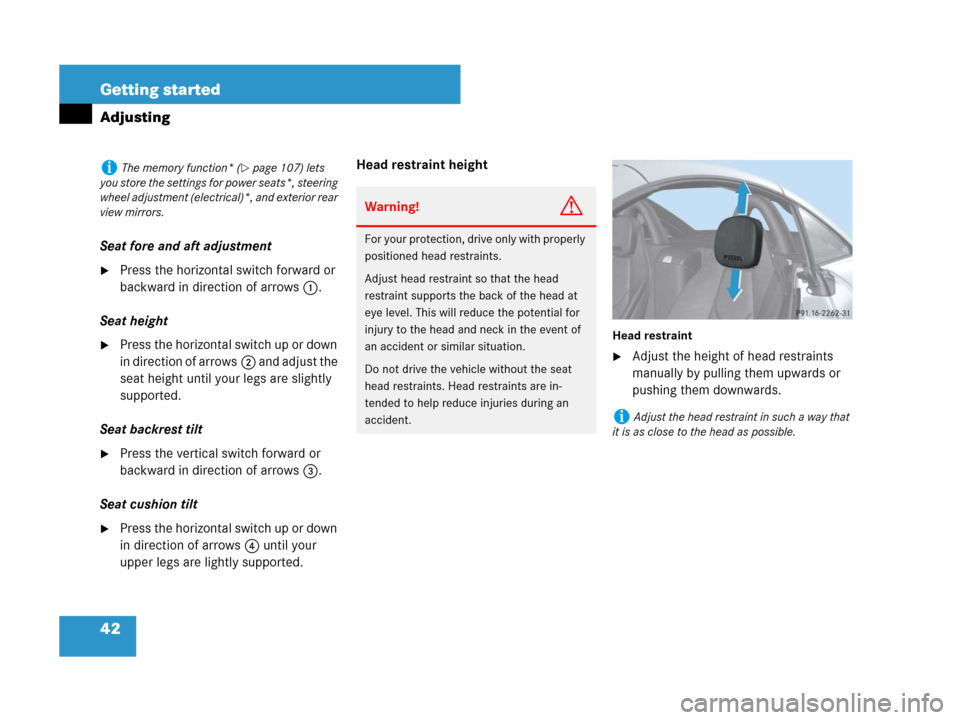
42 Getting started
Adjusting
Seat fore and aft adjustment
�Press the horizontal switch forward or
backward in direction of arrows1.
Seat height
�Press the horizontal switch up or down
in direction of arrows2 and adjust the
seat height until your legs are slightly
supported.
Seat backrest tilt
�Press the vertical switch forward or
backward in direction of arrows3.
Seat cushion tilt
�Press the horizontal switch up or down
in direction of arrows4 until your
upper legs are lightly supported.Head restraint height
Head restraint
�Adjust the height of head restraints
manually by pulling them upwards or
pushing them downwards.
iThe memory function* (�page 107) lets
you store the settings for power seats*, steering
wheel adjustment (electrical)*, and exterior rear
view mirrors.
Warning!G
For your protection, drive only with properly
positioned head restraints.
Adjust head restraint so that the head
restraint supports the back of the head at
eye level. This will reduce the potential for
injury to the head and neck in the event of
an accident or similar situation.
Do not drive the vehicle without the seat
head restraints. Head restraints are in-
tended to help reduce injuries during an
accident.
iAdjust the head restraint in such a way that
it is as close to the head as possible.
Page 44 of 473
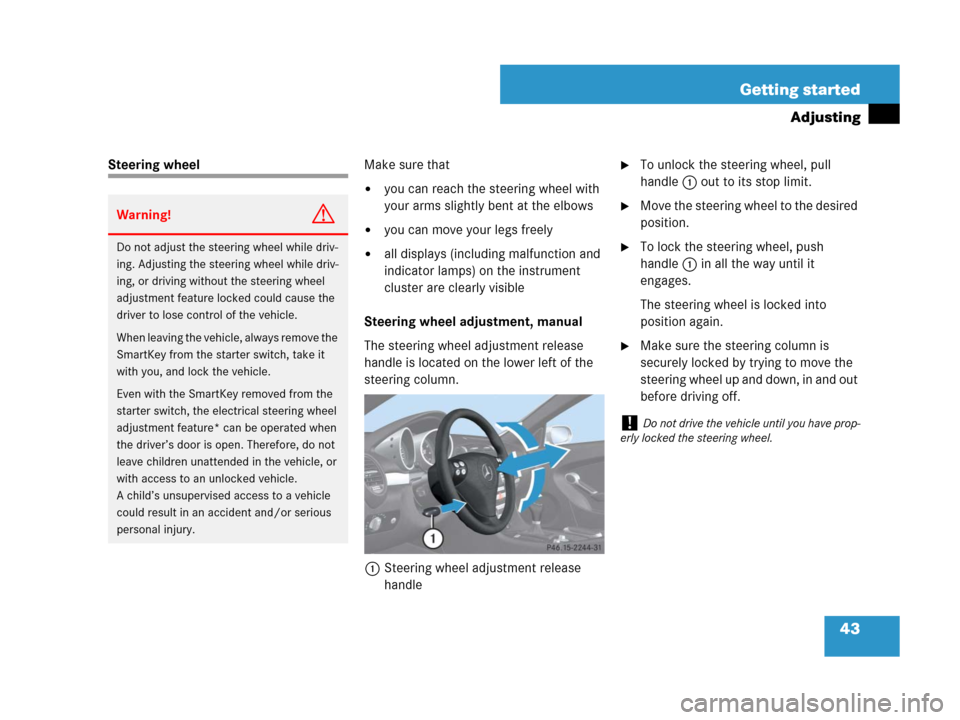
43 Getting started
Adjusting
Steering wheelMake sure that
�you can reach the steering wheel with
your arms slightly bent at the elbows
�you can move your legs freely
�all displays (including malfunction and
indicator lamps) on the instrument
cluster are clearly visible
Steering wheel adjustment, manual
The steering wheel adjustment release
handle is located on the lower left of the
steering column.
1Steering wheel adjustment release
handle
�To unlock the steering wheel, pull
handle1 out to its stop limit.
�Move the steering wheel to the desired
position.
�To lock the steering wheel, push
handle1 in all the way until it
engages.
The steering wheel is locked into
position again.
�Make sure the steering column is
securely locked by trying to move the
steering wheel up and down, in and out
before driving off.
Warning!G
Do not adjust the steering wheel while driv-
ing. Adjusting the steering wheel while driv-
ing, or driving without the steering wheel
adjustment feature locked could cause the
driver to lose control of the vehicle.
When leaving the vehicle, always remove the
SmartKey from the starter switch, take it
with you, and lock the vehicle.
Even with the SmartKey removed from the
starter switch, the electrical steering wheel
adjustment feature* can be operated when
the driver’s door is open. Therefore, do not
leave children unattended in the vehicle, or
with access to an unlocked vehicle.
A child’s unsupervised access to a vehicle
could result in an accident and/or serious
personal injury.
!Do not drive the vehicle until you have prop-
erly locked the steering wheel.
Page 45 of 473
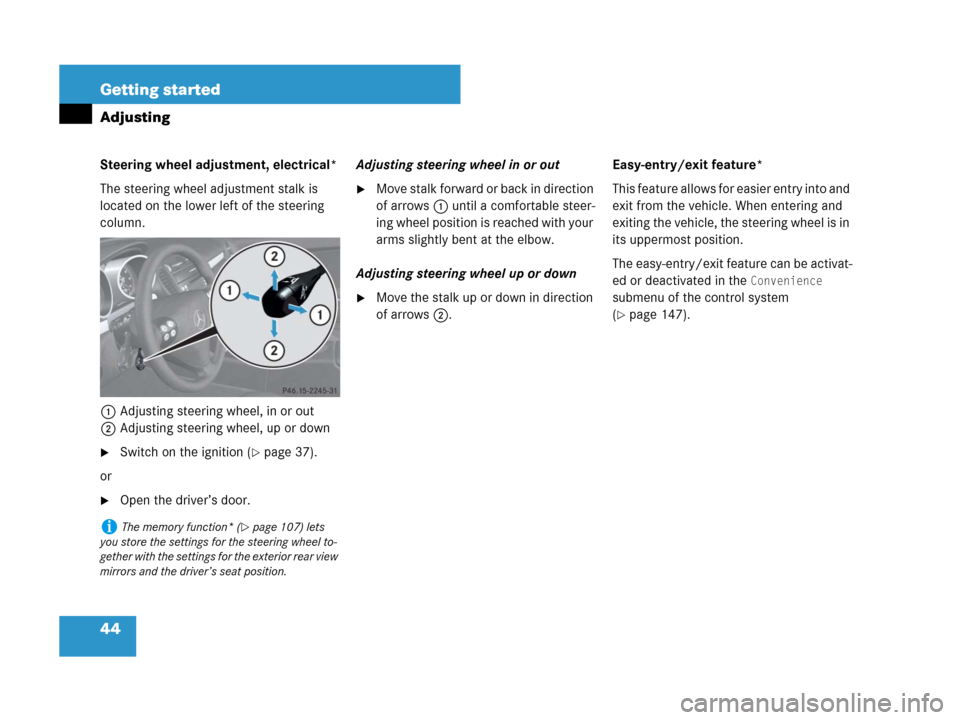
44 Getting started
Adjusting
Steering wheel adjustment, electrical*
The steering wheel adjustment stalk is
located on the lower left of the steering
column.
1Adjusting steering wheel, in or out
2Adjusting steering wheel, up or down
�Switch on the ignition (�page 37).
or
�Open the driver’s door.Adjusting steering wheel in or out
�Move stalk forward or back in direction
of arrows1 until a comfortable steer-
ing wheel position is reached with your
arms slightly bent at the elbow.
Adjusting steering wheel up or down
�Move the stalk up or down in direction
of arrows2.Easy-entry/exit feature*
This feature allows for easier entry into and
exit from the vehicle. When entering and
exiting the vehicle, the steering wheel is in
its uppermost position.
The easy-entry/exit feature can be activat-
ed or deactivated in the
Convenience
submenu of the control system
(
�page 147).
iThe memory function* (�page 107) lets
you store the settings for the steering wheel to-
gether with the settings for the exterior rear view
mirrors and the driver’s seat position.
Page 46 of 473
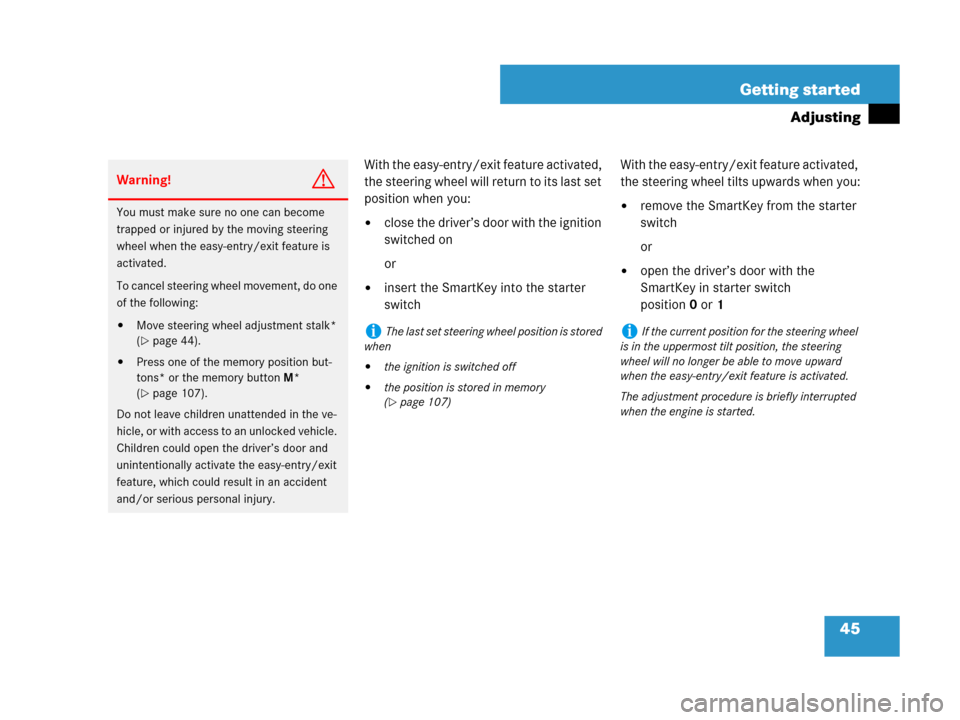
45 Getting started
Adjusting
With the easy-entry/exit feature activated,
the steering wheel will return to its last set
position when you:
�close the driver’s door with the ignition
switched on
or
�insert the SmartKey into the starter
switchWith the easy-entry/exit feature activated,
the steering wheel tilts upwards when you:
�remove the SmartKey from the starter
switch
or
�open the driver’s door with the
SmartKey in starter switch
position0or1
Warning!G
You must make sure no one can become
trapped or injured by the moving steering
wheel when the easy-entry/exit feature is
activated.
To cancel steering wheel movement, do one
of the following:
�Move steering wheel adjustment stalk*
(
�page 44).
�Press one of the memory position but-
tons* or the memory buttonM*
(
�page 107).
Do not leave children unattended in the ve-
hicle, or with access to an unlocked vehicle.
Children could open the driver’s door and
unintentionally activate the easy-entry/exit
feature, which could result in an accident
and/or serious personal injury.
iThe last set steering wheel position is stored
when
�the ignition is switched off
�the position is stored in memory
(
�page 107)
iIf the current position for the steering wheel
is in the uppermost tilt position, the steering
wheel will no longer be able to move upward
when the easy-entry/exit feature is activated.
The adjustment procedure is briefly interrupted
when the engine is started.
Page 47 of 473
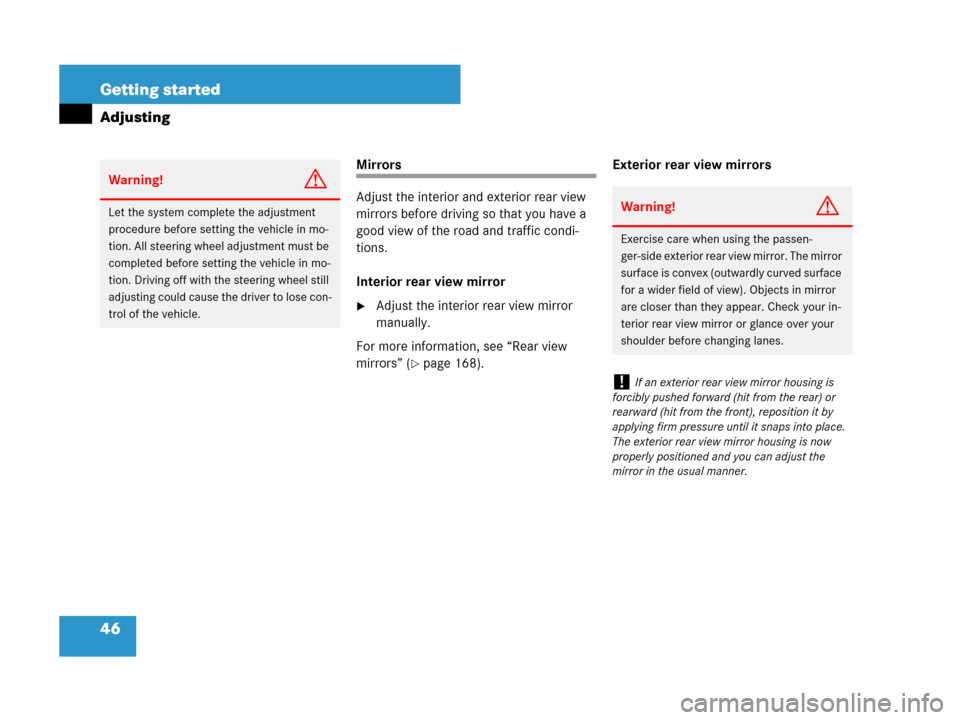
46 Getting started
Adjusting
Mirrors
Adjust the interior and exterior rear view
mirrors before driving so that you have a
good view of the road and traffic condi-
tions.
Interior rear view mirror
�Adjust the interior rear view mirror
manually.
For more information, see “Rear view
mirrors” (
�page 168).Exterior rear view mirrors
Warning!G
Let the system complete the adjustment
procedure before setting the vehicle in mo-
tion. All steering wheel adjustment must be
completed before setting the vehicle in mo-
tion. Driving off with the steering wheel still
adjusting could cause the driver to lose con-
trol of the vehicle.Warning!G
Exercise care when using the passen-
ger-side exterior rear view mirror. The mirror
surface is convex (outwardly curved surface
for a wider field of view). Objects in mirror
are closer than they appear. Check your in-
terior rear view mirror or glance over your
shoulder before changing lanes.
!If an exterior rear view mirror housing is
forcibly pushed forward (hit from the rear) or
rearward (hit from the front), reposition it by
applying firm pressure until it snaps into place.
The exterior rear view mirror housing is now
properly positioned and you can adjust the
mirror in the usual manner.
Page 56 of 473
55 Getting started
Driving
Switching on headlamps
Low beam headlamps
The exterior lamp switch is located on the
dashboard to the left of the steering wheel.
Exterior lamp switch
1Off
2Low beam headlamps on
�Turn the exterior lamp switch to
positionB.
The low beam headlamps come on.High beam
The combination switch is located on the
left of the steering column.
Combination switch
1High beam
2High beam flasher
�Push the combination switch in
direction of arrow1.
The high beam headlamps and high
beam headlamp indicator lampA in
the instrument cluster come on
(
�page 26).
For more information on headlamps, see
“Lighting” (
�page 109).
Turn signals
The combination switch is located on the
left of the steering column.
Combination switch
1Turn signals, right
2Turn signals, left
Page 60 of 473
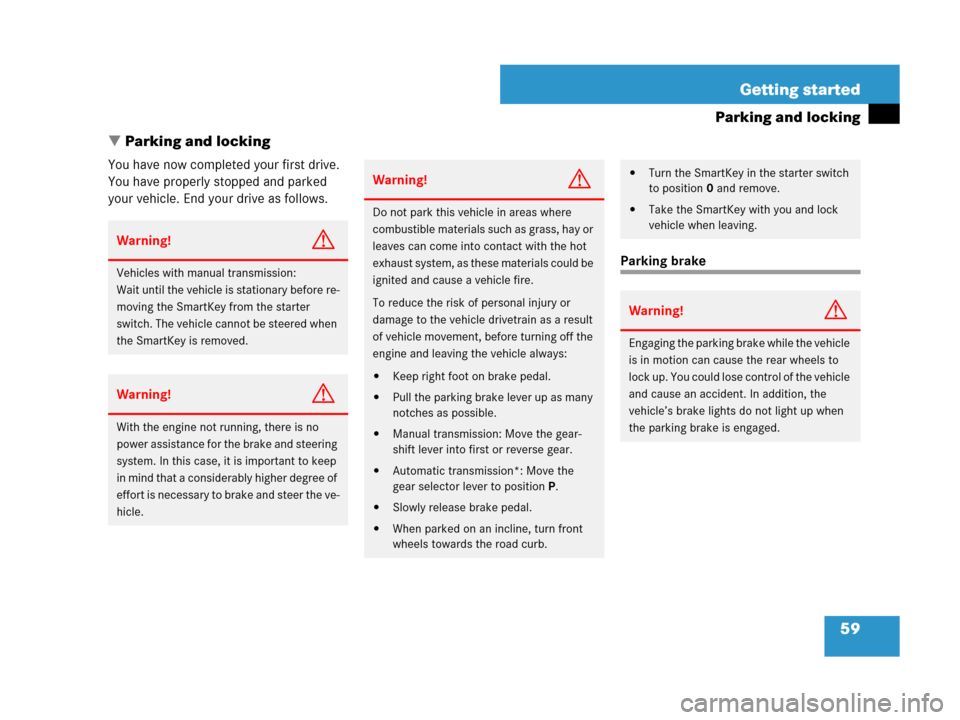
59 Getting started
Parking and locking
�Parking and locking
You have now completed your first drive.
You have properly stopped and parked
your vehicle. End your drive as follows.
Parking brake
Warning!G
Vehicles with manual transmission:
Wait until the vehicle is stationary before re-
moving the SmartKey from the starter
switch. The vehicle cannot be steered when
the SmartKey is removed.
Warning!G
With the engine not running, there is no
power assistance for the brake and steering
system. In this case, it is important to keep
in mind that a considerably higher degree of
effort is necessary to brake and steer the ve-
hicle.
Warning!G
Do not park this vehicle in areas where
combustible materials such as grass, hay or
leaves can come into contact with the hot
exhaust system, as these materials could be
ignited and cause a vehicle fire.
To reduce the risk of personal injury or
damage to the vehicle drivetrain as a result
of vehicle movement, before turning off the
engine and leaving the vehicle always:
�Keep right foot on brake pedal.
�Pull the parking brake lever up as many
notches as possible.
�Manual transmission: Move the gear-
shift lever into first or reverse gear.
�Automatic transmission*: Move the
gear selector lever to position P.
�Slowly release brake pedal.
�When parked on an incline, turn front
wheels towards the road curb.
�Turn the SmartKey in the starter switch
to position0 and remove.
�Take the SmartKey with you and lock
vehicle when leaving.
Warning!G
Engaging the parking brake while the vehicle
is in motion can cause the rear wheels to
lock up. You could lose control of the vehicle
and cause an accident. In addition, the
vehicle’s brake lights do not light up when
the parking brake is engaged.